Spironolactone – Mechanism, side effects, interactions and precautions
by egpat 17 Mar 2020
Spironolactone is a potassium sparing diuretic that can be used in variety of clinical indications most of them are related to its diuretic actions. But why it is named as spironolactone? Is this compound has any lactone ring just like digoxin. Exactly! It has that ring but with a little additional feature.
Even both of these drugs have steroid nucleus and lactone ring still digoxin and spironolactone differ in many aspects. One of the important differences is the existence of lactone ring. In digoxin, it is connected by single bond while in the spironolactone it is attached by a unique linkage that is “spiro”.
Chemical nature of spironolactone
Spironolactone, as its name indicates, it has a spiro linkage where a steroid ring is directly attached to five membered lactone ring without any linkage in between them. In another words, both of the rings have same carbon as common atom.
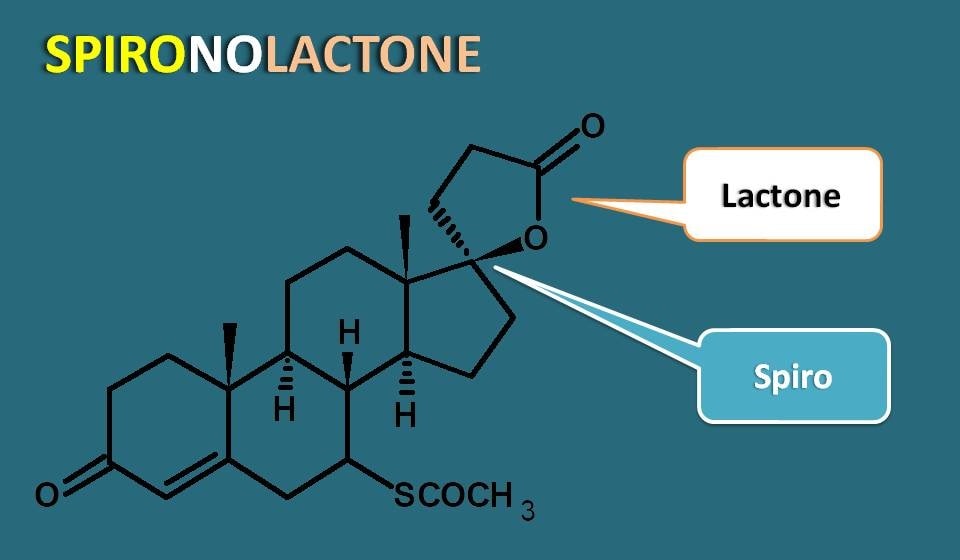
That’s fine, but which type of steroid nucleus it has? If we observe the structure we can find a steroid nucleus with 21 carbons extended with an ester group forming the lactone ring. So simply it has pregnane nucleus and we can also find a double bond at 4th position therefore it has pregn-4-ene nucleus. What about that extra ester functional group? That can be considered as a carbolactone formed in between C17 and C21 carbons. Therefore we can write spironolactone as Pregn-4-en-17,21-carbolactone derivative.
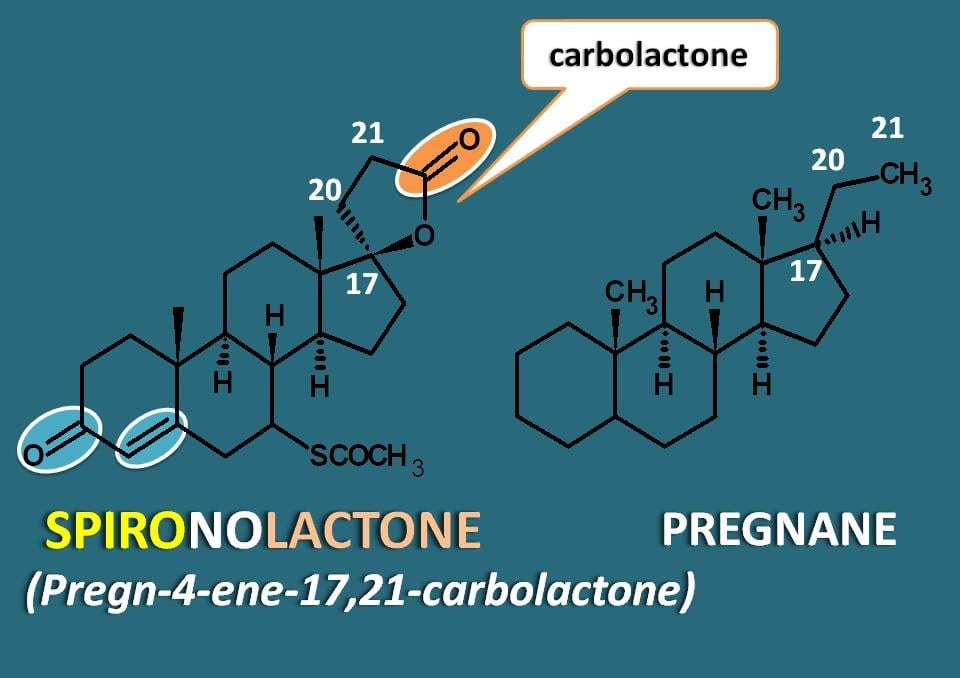
How spironolactone acts?
Now let’s see the mechanism of spironolactone. We already know that it is a potassium sparing diuretic, so its primary target of action is on the renal tubules of nephron. Within in the renal tubules, it acts on collecting tubules where normally ions like sodium and potassium can’t cross easily and they need specialized mechanism to transport these ions. The inner membrane of the renal tubule is called apical membrane and outer membrane is called as basolateral membrane. On this inner apical membrane, sodium channels are expressed through which sodium can enter into the membrane.
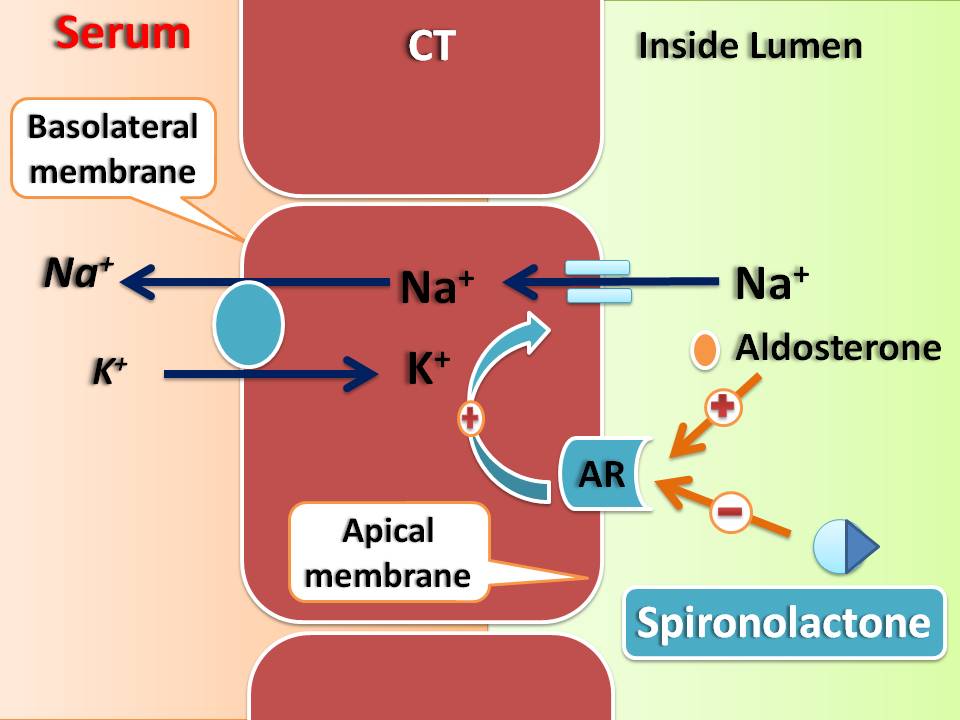
Once the sodium is within the membrane, further transport of ions is an easy process as the basolateral membrane is expressed by Na+/K+-ATPase pump which drives the sodium into the systemic circulation for the exchange of potassium. Now this potassium can be secreted into the renal tubule which is then excreted.
Great! But which trigger makes the expression of sodium channels on the apical membrane? Yes, it’s all due to release of aldosterone from adrenal cortex which acts on aldosterone receptors within the collecting tubules promoting gene transcription and protein synthesis. This results in synthesis of more number of sodium channels which are well expressed on the apical membrane promoting re-absorption of sodium.
Here spironolactone plays a key role. This drug acts as a competitive antagonist therefore binds to the aldosterone receptors preventing the binding of aldosterone. This results in the decreased expression of sodium channels on apical membrane and therefore sodium reabsorption is reduced.
Since sodium is not reabsorbed it is not available for exchange at basolateral membrane therefore potassium is neither exchanged nor secreted into the lumen. In this way, spironolactone retains the potassium in the body resulting in the potassium sparing effect.
Metabolism of spironolactone
How this drug may be metabolized? We can find an acetylthio group at 6th position in the Spironolactone which can be easily removed. So this group can hydrolyzed and deacetylated to give a free thiol group. This thiol can be further removed to produce a double bond at 6th position to yield an important metabolite Canrenone.
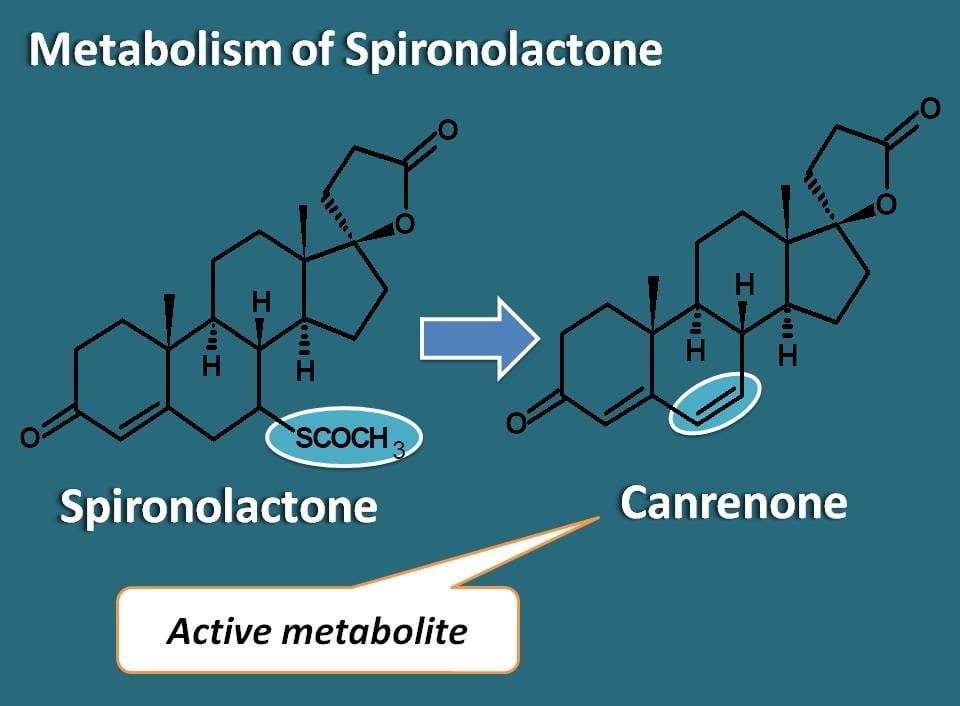
Interestingly, canrenone is an active metabolite of spironolactone that has long half life than the parent drug. Apart from this, canrenone shows more anti-adrogenic actions than spironolactone leading to more pronounced adverse effects.
How spironolactone is given?
Based on the various clinical usages, this drug is available as tablet, suspension and even in the gel form combined with other drugs. As a tablet it is available in the doses of 25 mg to 100 mg per each tablet. Similarly, it is available as a suspension of 25mg per 5 ml. Finally this drug is available at strengths between 2-5% in gel form.

What are the side effects?
As a diuretic, spironolactone can produce few of the side effects related to its renal actions and as a steroidal drug it can produce few of the side effects related to steroidal hormones. First let’s see here few of the renal side effects.
Renal actions producing hyper conditions
As the drug is potassium sparing diuretic, it retains the potassium in the body resulting in elevated levels of potassium, that is, hyperkalemia.
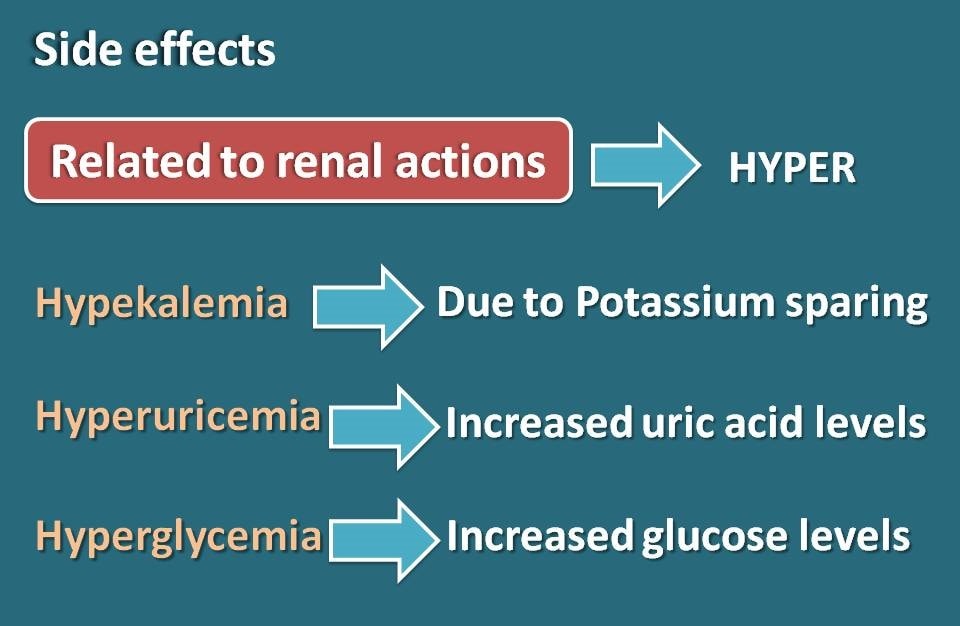
Similar to loop and thiazide diuretics, it can also increase the uric acid levels resulting in hyperuricemia. It can also increase glucose levels leading to hyperglycemia. So these are the three hyper conditions produced by spironolactone.
Renal actions producing hypo conditions
Now let’s see hypo effects of this drug. As spironolactone increases the excretion of sodium, calcium and magnesium, it can produce hyponatremia, hypocalcaemia and hypomagnesaemia respectively. By excretion of all these ions, body volume is also reduced resulting in hypovolemia.
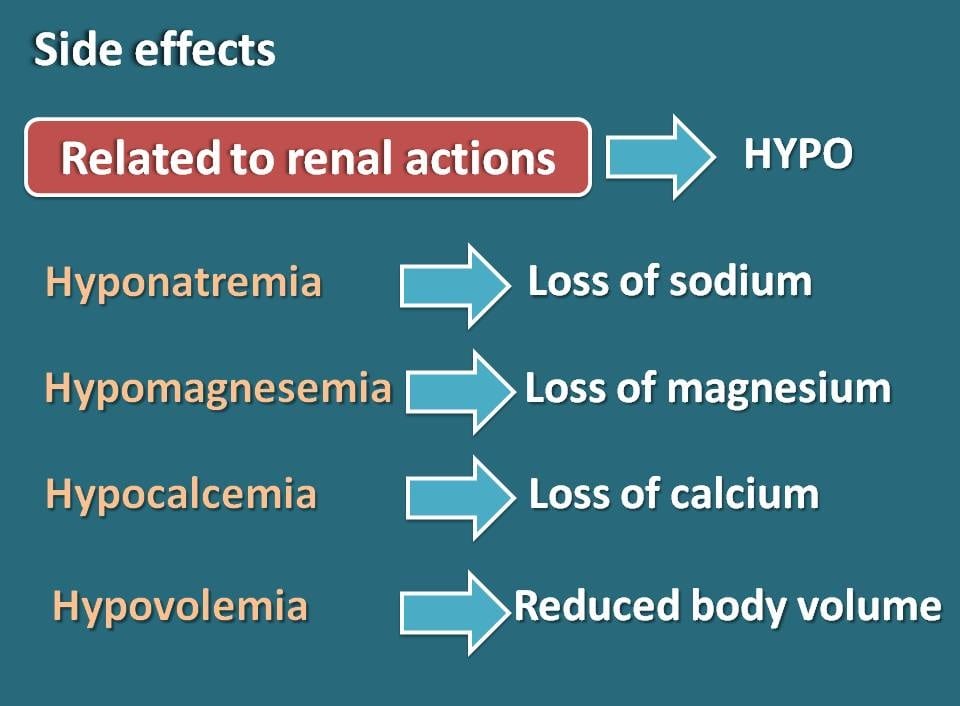
Non-renal actions
Spironolactone can produce few of the side effects that are not related to its renal actions. All these adverse effects are mainly due to its steroidal structure which shows some affinity towards the steroidal hormone receptors. One of its important affect is observed with androgen receptors. It blocks androgen receptors thereby it prevents the actions of testosterone. Apart from this it can also decrease synthesis of testosterone and even it can increase its clearance.
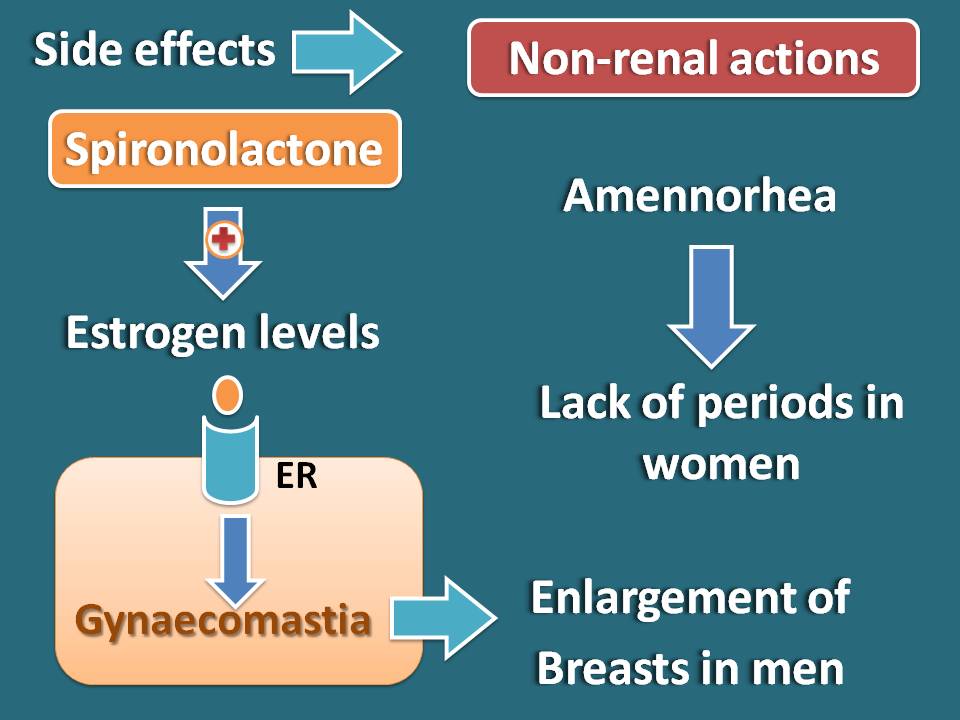
Due to all these anti-androgenic effects of spironolactone, estrogen levels may increase which results in gynaecomastia, enlargement of breast in the men. In females, spironolactone can produce menstrual irregularities and amenorrhea, a condition where there is absence of menstrual periods in women.
Other side effects
Dry mouth, nausea and vomiting are few of the other common side effects. Spironolactone can also increase hair growth, that’s why it is used in the treatment of loss of hair on scalp in the women.

Drug interactions
Since spironolactone is a diuretic that increases sodium excretion without loss of potassium, it reduces the body volume thereby it produces hypotensive effect. Therefore when this drug is given along with other antihypertensives such as prazosin and alfuzosin which produce significant hypotension, it results in serious interaction.
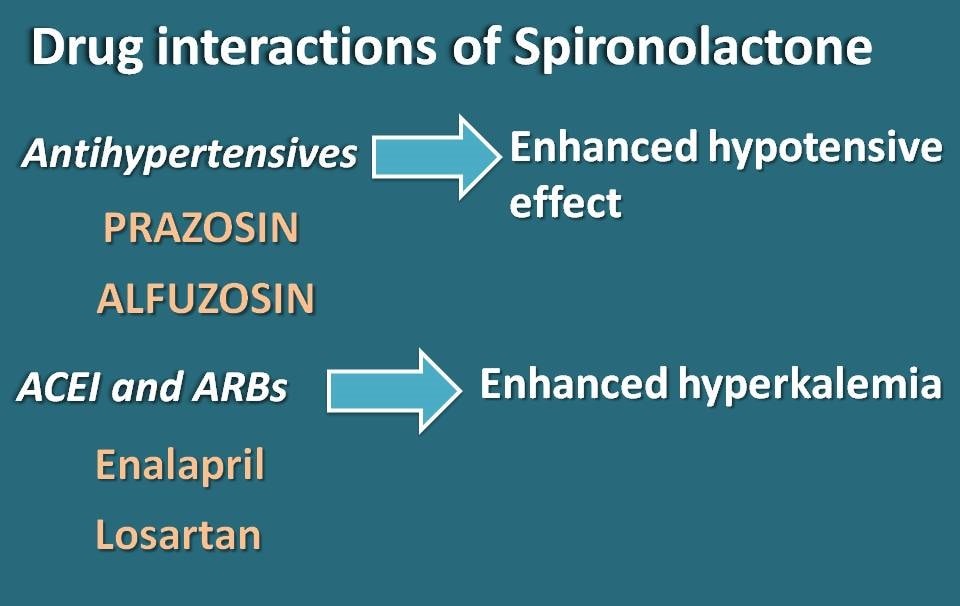
Again another significant interaction can be observed with ACE inhibitors and ARBs. These two categories of drugs can raise the potassium levels therefore they can increase the hyperkalemia produced by spironolactone. Similar effect can be observed with concomitant use of potassium supplements.
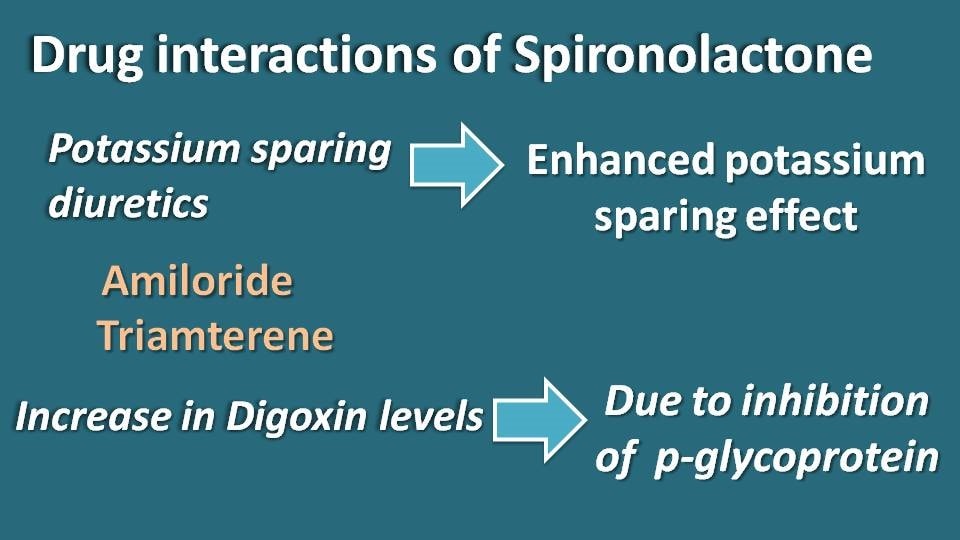
Interaction of spironolactone with digoxin is another important concern but works by different mechanism. Spironolactone acts as P-glycoprotein inhibitor thereby increases levels of digoxin leading to digoxin toxicity.

Just like other diuretics, spironolactone can also increase lithium toxicity. Lithium is a simple monovalent cation that acts as anti-manic agent in the treatment of bipolar depression. Since lithium and sodium are similarly charged, our physiological system more retains lithium for the loss of sodium by spironolactone. This results in accumulation of lithium resulting in its toxicity.
Spironolactone can also increase central effects of alcohol like sedation therefore consuming alcohol along with spironolactone is not preferred.
Precautions before use
Till now we have discussed the effects of spironolactone, possible side effects and interactions. Among them which should be considered before and even during the usage of this drug. Undoubtedly, we should take care of development of any hyperkalemia as retaining of potassium is the main action of spironolactone. So in patients with elevated levels of potassium or patients using drugs like ACE inhibitors, ARBs and potassium supplements, spironolactone should be carefully used.

Similarly spironolactone can increase uric acid levels and therefore it should be avoided in the patients with high risk of development of gout.

Another important precaution is the gynaecomastia and related disorders induced by spironolactone. Of course, these side effects are generally observed based on the dose and duration of treatment. So if a high dose of spironolactone is used for more than one month, any signs of gynaecomastia should be thoroughly checked.

Similar precautions should be taken before the use of this drug for a prolonged period as there is a risk of development of tumors with this drug.
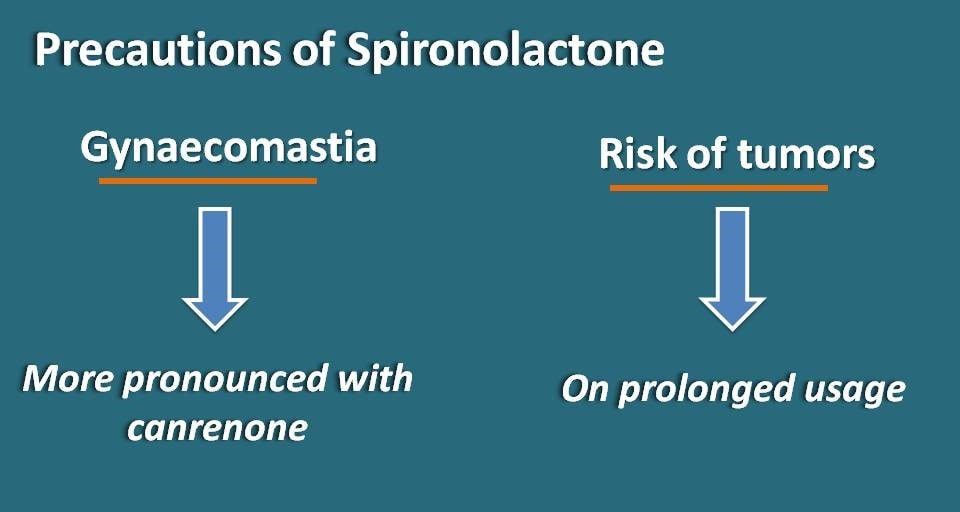
Clinical indications
Since spironolactone acts as competitive antagonist at the aldosterone receptors its main clinical use is in the treatment of hyperaldosteronism. It can be used before the surgery to reduce the size of the adrenal gland for a short period. It can also used to antagonize the mineralocoritcoid actions of adrenal tumors.

As it reduces the sodium levels and body volume, this drug can also be used in edema, severe heart failure and hypertension.

Quite interestingly, spironolactone can be used as off label purpose for few of the conditions that are related to its anti-androgenic activities. It can be used to treat hirsutism, unwanted hair growth in the women at the body areas where normally hair growth is not observed. At the same time, this drug can be used to promote hair growth at the scalp in the women.
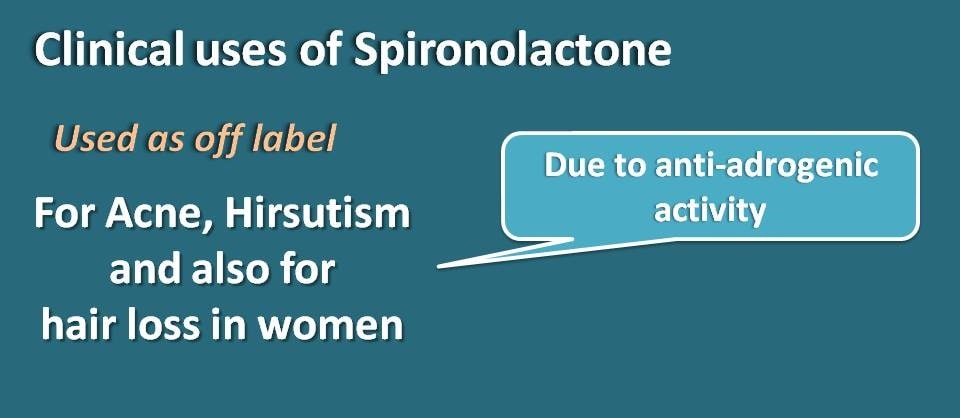
Conclusion
Spironolactone is a competitive aldosterone antagonist that can prevent the reabsorption of sodium through the ion channels at the collecting tubules. It increases sodium excretion but retains potassium. One of its metabolites canrenone is also active and shows more pronounced anti-androgenic effects than parent drug.
Hyperkalemia, gynaecomastia and possible drug interactions should be checked before the use of spironolactone. This drug can be used in various clinical conditions like hyperaldosteronism, severe heart failure and hypertension. It can also be used to promote hair growth as well as to prevent hair loss in women.